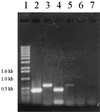Cloning, sequencing, and characterization of a gene cluster involved in EDTA degradation from the bacterium BNC1
- PMID: 11157232
- PMCID: PMC92636
- DOI: 10.1128/AEM.67.2.688-695.2001
Cloning, sequencing, and characterization of a gene cluster involved in EDTA degradation from the bacterium BNC1
Abstract
EDTA is a chelating agent, widely used in many industries. Because of its ability to mobilize heavy metals and radionuclides, it can be an environmental pollutant. The EDTA monooxygenases that initiate EDTA degradation have been purified and characterized in bacterial strains BNC1 and DSM 9103. However, the genes encoding the enzymes have not been reported. The EDTA monooxygenase gene was cloned by probing a genomic library of strain BNC1 with a probe generated from the N-terminal amino acid sequence of the monooxygenase. Sequencing of the cloned DNA fragment revealed a gene cluster containing eight genes. Two of the genes, emoA and emoB, were expressed in Escherichia coli, and the gene products, EmoA and EmoB, were purified and characterized. Both experimental data and sequence analysis showed that EmoA is a reduced flavin mononucleotide-utilizing monooxygenase and that EmoB is an NADH:flavin mononucleotide oxidoreductase. The two-enzyme system oxidized EDTA to ethylenediaminediacetate (EDDA) and nitrilotriacetate (NTA) to iminodiacetate (IDA) with the production of glyoxylate. The emoA and emoB genes were cotranscribed when BNC1 cells were grown on EDTA. Other genes in the cluster encoded a hypothetical transport system, a putative regulatory protein, and IDA oxidase that oxidizes IDA and EDDA. We concluded that this gene cluster is responsible for the initial steps of EDTA and NTA degradation.
Figures





Similar articles
-
Structural and biochemical characterization of EDTA monooxygenase and its physical interaction with a partner flavin reductase.Mol Microbiol. 2016 Jun;100(6):989-1003. doi: 10.1111/mmi.13363. Epub 2016 Apr 13. Mol Microbiol. 2016. PMID: 26928990 Free PMC article.
-
Identification, purification, and characterization of iminodiacetate oxidase from the EDTA-degrading bacterium BNC1.Appl Environ Microbiol. 2001 Feb;67(2):696-701. doi: 10.1128/AEM.67.2.696-701.2001. Appl Environ Microbiol. 2001. PMID: 11157233 Free PMC article.
-
Cloning, sequencing, and analysis of a gene cluster from Chelatobacter heintzii ATCC 29600 encoding nitrilotriacetate monooxygenase and NADH:flavin mononucleotide oxidoreductase.J Bacteriol. 1997 Feb;179(4):1112-6. doi: 10.1128/jb.179.4.1112-1116.1997. J Bacteriol. 1997. PMID: 9023192 Free PMC article.
-
Purification and characterization of EDTA monooxygenase from the EDTA-degrading bacterium BNC1.J Bacteriol. 1998 Aug;180(15):3823-7. doi: 10.1128/JB.180.15.3823-3827.1998. J Bacteriol. 1998. PMID: 9683478 Free PMC article.
-
Environmental fate and microbial degradation of aminopolycarboxylic acids.FEMS Microbiol Rev. 2001 Jan;25(1):69-106. doi: 10.1111/j.1574-6976.2001.tb00572.x. FEMS Microbiol Rev. 2001. PMID: 11152941 Review.
Cited by
-
Biochemical characterization of NADH:FMN oxidoreductase HcbA3 from Nocardioides sp. PD653 in catalyzing aerobic HCB dechlorination.J Pestic Sci. 2020 Aug 20;45(3):125-131. doi: 10.1584/jpestics.D20-23. J Pestic Sci. 2020. PMID: 32913414 Free PMC article.
-
Identification and Characterization of a DmoB Flavin Oxidoreductase from a Putative Two-Component DMS C-Monooxygenase.ACS Omega. 2020 Apr 15;5(17):9830-9838. doi: 10.1021/acsomega.9b04489. eCollection 2020 May 5. ACS Omega. 2020. PMID: 32391470 Free PMC article.
-
Identification of the hcb Gene Operon Involved in Catalyzing Aerobic Hexachlorobenzene Dechlorination in Nocardioides sp. Strain PD653.Appl Environ Microbiol. 2017 Sep 15;83(19):e00824-17. doi: 10.1128/AEM.00824-17. Print 2017 Oct 1. Appl Environ Microbiol. 2017. PMID: 28733287 Free PMC article.
-
Structure of the metal-independent restriction enzyme BfiI reveals fusion of a specific DNA-binding domain with a nonspecific nuclease.Proc Natl Acad Sci U S A. 2005 Nov 1;102(44):15797-802. doi: 10.1073/pnas.0507949102. Epub 2005 Oct 24. Proc Natl Acad Sci U S A. 2005. PMID: 16247004 Free PMC article.
-
Structural and biochemical characterization of EDTA monooxygenase and its physical interaction with a partner flavin reductase.Mol Microbiol. 2016 Jun;100(6):989-1003. doi: 10.1111/mmi.13363. Epub 2016 Apr 13. Mol Microbiol. 2016. PMID: 26928990 Free PMC article.
References
-
- Alder A C, Siegrist H, Gujer W, Giger W. Behavior of NTA and EDTA in biological wastewater treatment. Water Res. 1990;24:733–742.
-
- Ausubel M F. Current protocols in molecular biology. New York, N.Y: John Wiley & Sons, Inc.; 1993.
-
- Bergers P J M, DeGroot A C. The analysis of EDTA in water by HPLC. Water Res. 1994;28:639–642.
Publication types
MeSH terms
Substances
LinkOut - more resources
Full Text Sources

